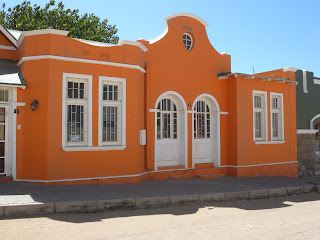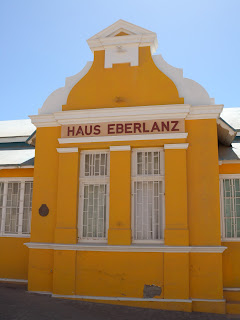Luderitz is a throw-back to German colonial times with its art nouveau architecture, bakeries and cafés. Poor transport links have kept it off the main tourist track, but it's worth swinging by if you're down in the south. The town was founded shortly after the discovery of diamonds in the Sperrgebiet area in 1908. It quickly became a boomtown as hordes of prospectors descended upon it and facilities sprang up to support the burgeoning diamond mining industry. Before things got out of control, the German government declared the south-west area of Namibia the "Forbidden Zone" and independent prospecting became illegal.
 |
| On the road to Luderitz |
 |
| Architecture around Luderitz |
From Luderitz, we came back to Kolmanskop which is probably one of the most surreal places I have ever visited. It's an old mining town that sprang up after the initial discovery of diamonds in the area, but when richer diamond fields were found around the mouth of the Orange River in 1928, the industry gradually migrated to Oranjemund and Kolmanskop became deserted. The last inhabitants left in 1956 and the desert sands have been gradually invading the town ever since. The ghost town was opened up as a tourist attraction about 20 years ago and it's possible to walk inside all the houses and see the sand piling up in the rooms. It's creatively inspiring enough to bring out the arty photographer in everyone.
The town was home to around 1,000 people in its heyday, including elegant German ladies in their long crinoline dresses. On the day we visited, there was a strong wind blowing and fine particles of sand flying everywhere. I cannot imagine living there in the middle of the desert on a permanent basis. It must have been boring as hell and so to provide distraction, the town had its own bowling alley, casino and even a theatre.
The story of the diamond discoveries in Southern Namibia is quite fascinating. It is said that a railway worker found a shiny stone alongside the railway track near Grasplatz and gave it to his employer, August Stauch. It was confirmed to be a diamond and the rest is history.. It is said that there were so many diamonds in the area that people were crawling through the desert on their hands and knees, picking diamonds up out of the sand. And this continued for the first 18 months or so after the initial discovery.
Today, the diamond industry is controlled by the Namdeb Diamond Corporation Ltd, which is jointly-owned by the Namibian government and the De Beers Group. As we toured through the reception area, we learned that the De Beers world-famous slogan - "A diamond is forever" - was voted the top advertising slogan of the century by the prestigious US magazine Advertising Age, in a special edition published in January 1990. The long-running advertising campaign successfully established the purchase of a diamond to denote engagement. As the world's hardest natural material, De Beers could certainly feel confident in standing behind their advertising claim that the diamond would indeed last "forever", if not the matrimonial bliss that it sought to commemorate.




















I spent a long weekend in Luderitz. My then partner had a diamond-diving concession and I was very fortunate to be allowed into areas which are forbidden to outsiders. My abiding memory is driving on the approach road at sunrise, awesome sight. And the sand dunes were simply stunning.
ReplyDelete